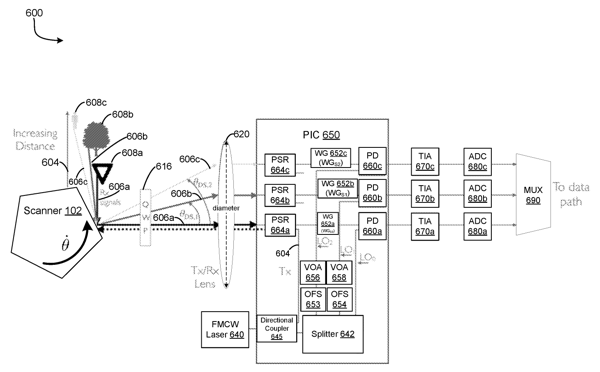| US 11,808,851 B2 | ||
| Techniques for enhanced detection of distant objects | ||
| Brian J. Roxworthy, San Jose, CA (US); Pradeep Srinivasan, Fremont, CA (US); and Ashwin Samarao, Sunnyvale, CA (US) | ||
| Assigned to Aeva, Inc., Mountain View, CA (US) | ||
| Filed by AEVA, INC., Mountain View, CA (US) | ||
| Filed on Jun. 20, 2022, as Appl. No. 17/844,442. | ||
| Application 17/844,442 is a continuation of application No. 17/495,665, filed on Oct. 6, 2021, granted, now 11,372,105, issued on Jun. 28, 2022. | ||
| Prior Publication US 2023/0138571 A1, May 4, 2023 | ||
| Int. Cl. G01S 17/32 (2020.01); G01S 7/4913 (2020.01); G01S 7/481 (2006.01) | ||
| CPC G01S 17/32 (2013.01) [G01S 7/4913 (2013.01); G01S 7/4817 (2013.01)] | 16 Claims |

|
1. A frequency modulated continuous wave (FMCW) light detection and ranging (LIDAR) system comprising:
one or more waveguides to:
receive a first returned reflection, and generate a first waveguide signal based on the first returned reflection; and
receive a second returned reflection, and generate a second waveguide signal based on the second returned reflection;
one or more photodetectors to:
one or more polarization splitter-rotators (PSRs) to:
generate, based on the first waveguide signal and a first local oscillator (LO) signal, a first output signal within a first frequency range; and
generate, based on the second waveguide signal and a second LO signal, a second output signal within a second frequency range;
convert, prior to the one or more waveguides to receive the first returned reflection, a polarization of the first returned reflection to match a polarization of the first LO signal to generate a converted first returned reflection; and
convert, prior to the one or more waveguides to receive the second returned reflection, a polarization of the second returned reflection to match a polarization of the second LO signal to generate a converted second returned reflection; and
an optical frequency shifter (OFS) to shift a frequency of the second LO signal to cause the second output signal to shift from within the second frequency range to within the first frequency range to generate a shifted signal for use in producing one or more points in a point set.
|